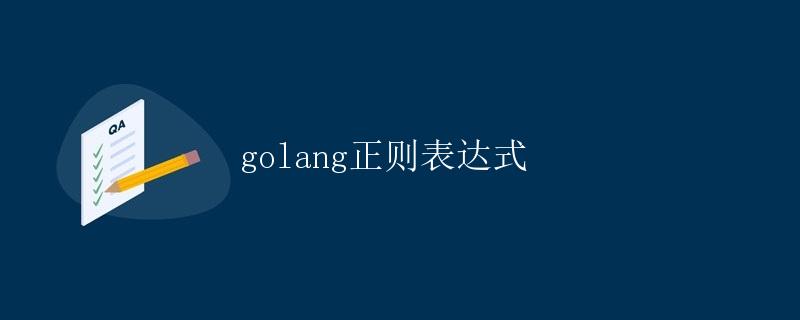golang正则表达式

在Golang中,正则表达式是处理文本的强大工具。它可以用来搜索、匹配和替换文本内容,帮助我们更高效地处理字符串操作。本文将详细介绍在Golang中使用正则表达式的方法和示例。
使用正则表达式的基本步骤
在Golang中,使用正则表达式的基本步骤如下:
- 导入正则表达式包:首先需要导入
regexp包,该包提供了操作正则表达式的函数和方法。
import "regexp"
- 编译正则表达式:通过
regexp.Compile或regexp.MustCompile函数编译正则表达式,生成一个Regexp对象。
re, err := regexp.Compile("ab.*cd")
if err != nil {
fmt.Println("Error compiling regex:", err)
return
}
- 使用正则表达式:利用
Match、MatchString、Find、FindAll等方法来对文本进行匹配。
text := "abcdefg"
match := re.MatchString(text)
if match {
fmt.Println("Match found!")
} else {
fmt.Println("No match found.")
}
基本匹配示例
接下来,我们通过一些示例来演示如何使用正则表达式在Golang中进行基本的匹配操作。
检测是否包含匹配项
re := regexp.MustCompile("hello")
text := "hello world"
match := re.MatchString(text)
fmt.Println(match) // Output: true
查找所有匹配项
re := regexp.MustCompile("good")
text := "good morning, good afternoon"
matches := re.FindAllString(text, -1)
fmt.Println(matches) // Output: [good good]
检测是否以匹配项开头
re := regexp.MustCompile("^hello")
text := "hello world"
match := re.MatchString(text)
fmt.Println(match) // Output: true
检测是否以匹配项结尾
re := regexp.MustCompile("world$")
text := "hello world"
match := re.MatchString(text)
fmt.Println(match) // Output: true
匹配某个范围的字符
re := regexp.MustCompile("[a-z]+")
text := "abc123def456"
matches := re.FindAllString(text, -1)
fmt.Println(matches) // Output: [abc def]
正则表达式语法
在Golang中,正则表达式的语法与其他编程语言中的语法有一些不同。以下是一些常用的正则表达式语法示例:
.:匹配任意单个字符。^:匹配字符串开始的位置。$:匹配字符串结束的位置。[]:匹配方括号中的任意一个字符。+:匹配前面的字符一次或多次。*:匹配前面的字符零次或多次。?:匹配前面的字符零次或一次。():创建一个捕获组。
更高级的匹配操作
除了基本的匹配操作外,Golang的正则表达式还提供了一些更高级的功能,如捕获组、替换和编译选项等。
捕获组
捕获组是一个用括号包含的子表达式,可以对它进行匹配、提取和替换。
re := regexp.MustCompile("(\w+)\s(\w+)")
text := "hello world"
matches := re.FindStringSubmatch(text)
fmt.Println(matches) // Output: [hello world hello world]
替换
使用ReplaceAllString方法可以将匹配的文本替换为指定的内容。
re := regexp.MustCompile("world")
text := "hello world"
newText := re.ReplaceAllString(text, "universe")
fmt.Println(newText) // Output: hello universe
编译选项
在编译正则表达式时,可以添加一些选项来控制匹配的行为,如大小写敏感、多行模式等。
re := regexp.MustCompile("(?i)hello")
text := "HELLO world"
match := re.MatchString(text)
fmt.Println(match) // Output: true
总结
通过本文我们学习了在Golang中使用正则表达式的基本步骤和示例,掌握了如何进行文本匹配、提取和替换操作。正则表达式是一个非常强大的工具,可以帮助我们更高效地处理字符串操作。
 极客教程
极客教程